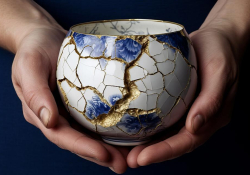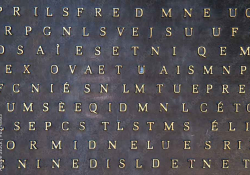An Eloquent Vernacular: Robert H. McCormick Jr. on Translating Évelyne Trouillot

In June 2000 a group of soldiers from the Dominican Republic opened fire on, and killed, seven people in a tarp-covered truck they were pursuing in Guayubín. The cadavers of the six Haitians were buried in a common grave, virtually forgotten until a court ruling (albeit nonbinding) twelve years later found the Dominican Republic guilty of massacre (December 10, 2012, “Le Nouvelliste”).
Évelyne Trouillot’s The Blue of the Island brings these spirits back to life. By staging their dialogue underneath the tarp’s camouflage, the play merges past and present. The simple, often blasphemous, interactions of the passengers eloquently express the ordinariness of their lives.
Much like the play in its original French, Robert H. McCormick Jr.’s translation renders the cargo’s simply expressed small talk unforgettable and profound. In so doing, the original French play, and its precise English translation, further merge the past’s bare grief with present eloquence, thus laying bare the horrific events of a night in June for an even-wider audience.
Jeremiah Gentle: What is your background in Caribbean literature? What about the region appeals to you?
Robert H. McCormick Jr.: I came to Caribbean literature later in my literary life. My point of entry was, without doubt, the work of Maryse Condé. I read all her novels assiduously many times. Franklin University’s academic travel program was a second major factor. I organized five two-week academic travels to Cuba for students, as well as one to Venezuela and a couple to the Dominican Republic. Thus, from Guadeloupe, the scope of my interest expanded to include a wider, polylingual Caribbean. To broaden my own understanding, and that of my students, I initiated the Franklin College Caribbean Conference in Lugano, which I organized every two years over a ten-year span. Besides meeting Haitian writers who were our guests, such as Jean-Claude Fignolé, I became familiar with Évelyne Trouillot’s play through the essay of a conference participant that we published in conjunction with the Journal of Haitian Studies.
With respect to what pleases me about the region, literature comes first. I won’t cite too many authors, but the work of J.-S. Alexis, Jacques Roumain, Alejo Carpentier, Edwidge Danticat, Junot Díaz, Louis-Philippe Dalembert, and Maryse Condé have all impressed and influenced me in different ways. I like the weather, of course, but most of all the open sociability of most Caribbeans, a characteristic I associate with their humanity and one that manifests itself in their language.
JG: What inspired you to begin working with translations?
It is the sensation of dealing with this fundamental manifestation of literature, its verbal essence, that gives me the greatest pleasure in translating.
RHM: I came to translation even later. I was, though, in a position to translate what I liked and what I thought interested readers might want to have access to. My first literary translation was an interview I recorded in Guadeloupe with Maryse Condé at her former home there. WLT published that interview (see WLT, Summer 2000, 519–28). Then there was a long break. The idea to translate Le Bleu de l’île came after reading Stéphanie Bérard’s article about the play and learning that it hadn’t yet been translated into English. At that time, it hadn’t even come out in the French edition published by Coulisses (Spring, 2012). Now that I have since translated a novel and started another, my thinking about translation has taken a slightly more philosophical bent. I was disillusioned with various types of literary “studies” and felt I was often being led away from literature, and from its words. It is the sensation of dealing with this fundamental manifestation of literature, its verbal essence, that gives me the greatest pleasure in translating. I also feel I am making more accessible some of the many riches of Haitian literature that may be beyond the reach of those who don’t know French well enough.
JG: What about Trouillot’s work strikes you as unique, and how does it capture the essence of Haitian culture?
RHM: I’ll limit my remarks to this play, although I am familiar with The Infamous Rosalie, Trouillot’s novel that traces the expanding consciousness of a young slave girl at the time of the outbreak of the Haitian Revolution, and the more recent Absences sans frontiers (see WLT, Jan. 2014, 66), the contemporary setting of which alternates between Haiti and North America.
Thus, Trouillot delineates the psychological turmoil in the minds of those leaving.
The Blue of the Island is unique because of its unusual setting and especially because of the interactions among the widely divergent characters from the same village, Piment, that are literally thrown on top of one other under the blue tarp of the speeding truck. As in Sartre’s No Exit, these interactions force the characters to reveal uncomfortable truths. Besides explaining why the pastry shop Bonne Bouche isn’t profitable—the humorous explanation is that Lorette discovers she’s allergic to flour and vanilla extract—Trouillot gives the reaction of Lorette’s older sister, who is angry that valuable, hard-to-come-by family resources have been wasted on Lorette’s education and the failed commercial enterprise. Fifi reveals that her deepest emotional attachment is for someone other than the father of the child she is bringing up. Marie-Jeanne explains that she’s leaving her three children behind because her husband beats her in response to the gradual decline in profits from his shoe-repair shop. The decline can, in fact, be attributed to a flooding of the market with cheap new shoes mass-produced in America. Ronald bemoans the desperation—he was robbed by a business partner—that led to his making violent love, once, with a woman he detested on the day of his mother’s funeral. Thus, Trouillot delineates the psychological turmoil in the minds of those leaving. To that end, the author innovatively brings back characters who have died to interact, as ghosts, with those riding in the back of the truck. Thus, she concretely stages the relation of past to present while examining the mechanisms of memory, such as guilt.
JG: Why translate this play about Haitians seeking a better life in the neighboring Dominican Republic by way of a tarp-covered truck?
RHM: Why did I translate this play? Primarily because of its dominant metaphor: a representative group of Haitians in a tarp-covered truck heading clandestinely for the border in the vicinity of Dajabón. I was impressed by the author’s use of the inhabitants of a village as various types of motivation: to escape the futility of their modest business ventures, to reunite with Spanish-speaking family members, to locate a lost lover, to set up a more extensive transnational network of drug trafficking or even a more lucrative barbershop. Then there was the tarp’s effect of denying them the ever-present, free, liberating, unifying blue sky of the divided island. It was only after having finished the translation that Trouillot sent me an article about the trial of those responsible for the deaths. Reading that article from Le Nouvelliste (December 10, 2012), I discovered that the play was based on an actual historical event, that it was an imaginative re-creation of reality.
Many Haitian authors comment, most often ironically, on the grass-is-greener conception of life in the Dominican Republic. Trouillot gives her view through the ending. For me, the ideas, images, and even some expressions were fresh. In addition, the characters provide new insights into the quotidian experience of many Haitians. Thus, I contacted the author and asked her if I could translate Le Bleu de l’île.
JG: Were there any challenges in translating a play that you would not encounter translating a novel? Were any colloquialisms or other elements lost in translating the play?
RHM: The primary challenge of translation is linguistic in nature. As opposed to a novel, which has multiple narrative modes at its disposal, a play generally has only one, its dialogue, its spoken language. Thus, in a certain sense, a play is less complicated, or at least more monolithic, on a purely textual level. The challenge is to approximate, in a different language, the richness of the colloquial language of the original text. One difficult aspect was finding the appropriate corresponding expressions for vulgarity and blasphemy. Then there were the eloquent expressions the author used. Man Etienne is described, after the death of her twins, as having pulled a veil over joy. I always wanted to respect the literal freshness of that type of expression. Then there was the pastry shop named “Bonne Bouche.” “The Good Mouth”? We also needed to determine the role of Kreyòl, a language born in the Caribbean and used in everyday life, but not a major part of the play. The author, for example, didn’t want the title of one of the children’s songs to be translated. Other expressions, such as zenglendo, we kept in the original and glossed with a footnote formulated by the author.
Was something “lost in translation”? I suppose so, but not much! It seems more important to note that something was gained. Le Bleu de l’île is now accessible to a larger audience. Ideally, The Blue of the Island will be read, and a director will decide to stage it. For both the author and the translator, that was the ultimate goal. You have read Trouillot’s play and are eliciting commentary about it. Thus, in some sense, our goals have, in part at least, been realized.
JG: As a professor of creative writing at Franklin University, what are your hopes for educating people about Haitian and Caribbean culture?
RHM: I have not used this play in a creative writing course as I generally work with prose. From my perspective as a professor, the translation was intended to interest those desirous of understanding, in a more profound way, everyday life in Haiti. The play makes clear that a better understanding of the dynamics responsible for individual actions, the context of that everyday life, involves history, politics, and the complex racial relations between Haiti and the Dominican Republic on the once-unified island. Hopefully, Trouillot’s play helps us better understand the social, economic, and political conditions that bring about the desire, the need, to leave one’s country. Haitian authors insist on the psychological dimension as well: ruminations about risk, social pressure, the consequences of success, or failure, for the family, the desperation, the predeparture conception of the primary destinations, the Dominican Republic and the United States, the forced departure from a country one loves, a sentiment brilliantly rendered by the author’s use of Ti-Corn’s song “Ma prale” (“Je m’en vais”) in the moving scene at the airport. (Editorial note: To watch videos of TiCorn’s music, visit www.ticorn.com.)
The problems of emigration are legion, and it is a global phenomenon. In the States, we have often thought of Mexico, but now we think of Syria, Iraq, North Africa, and Lampedusa as well as Haiti. Perhaps the mise-en-scène of this small, tarp-covered flatbed truck, the human beings crowded together inside, fearful, and the dangers they face allows us to understand, in a more sympathetic way, not only the dynamics of the dramatic choices many Haitians were forced to make but also the global phenomenon of millions of forced departures from one’s native land.
June 2014
Évelyne Trouillot. The Blue of the Island. Robert H. McCormick Jr., tr. Journal of Haitian Studies 18.2 (2012): 210–264.
Robert H. McCormick Jr.’s translation of Évelyne Trouillot’s play Le Bleu de l’île presents an opportunity for English speakers desiring to immerse themselves in both Haitian reality and literature. The translation reveals to neophytes the tensions between Haiti and the Dominican Republic, two countries sharing the same island. On the eastern end of the island, the relatively prosperous D. R. attracts Haitians fleeing their homeland. The sixteen Haitian characters of the play all share and pursue the same dream, that of crossing the border to reach what they believe to be improved conditions and a better life. In turn, they share their stories in a dramatic fashion that points out the desperation, disillusion, and failure that are part of their everyday lives. Some motifs are tragically recurrent: the absence of the father figure, the death of very young children, and the alienating relationships between men and women.
In many respects, the translation preserves the identity and the flavor of Trouillot’s work. Indeed, one feels no loss when comparing the two versions; McCormick’s transcription adequately reflects Le Bleu de l’île. First, the translation keeps alive the vernacular tone in which Trouillot’s characters, mostly humble Haitians belonging to the struggling working class, express themselves. In addition to the vernacular speech, the play adds another layer of difficulty when it comes to translation. As the characters undertake their journey toward the Dominican Republic, they encounter difficulties and stress, which lead them to employ a series of profanities and blasphemies. McCormick translates all these profane expressions with colloquial phrasing that rightly conveys their colorfulness without unnecessary vulgarity. To conclude, McCormick’s translation is a precious gift to readers, for it demonstrates both precision and quality.
Rokiatou Soumaré
University of Oklahoma












